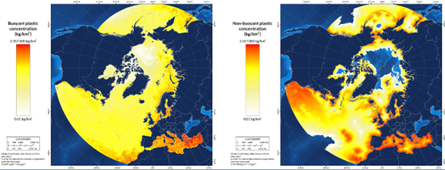Oceana model shows extent of plastic crisis on the seabed
Plastic Knows No Political Boundaries
Press Release Date: May 25, 2023
Location: Madrid
Contact:
Natividad Sánchez | email: nsanchez@oceana.org | tel.: +34 687 598 529
Oceana today released an advanced computational model that predicts the pathways and accumulation zones for plastic waste in the ocean, demonstrating that plastic travels long distances, not only at the surface, but also on the seabed.
“15 million tonnes of plastic getting into our ocean every year is a global crisis which requires governments to act immediately,” said Vera Coelho, Oceana’s deputy vice-president for Europe. “We must reduce unnecessary single-use plastics at the source, and that must be the focus of national and international policies.” The model, accessible through a viewer, encompasses more than 51,000,000 km2 and covers all European and parts of North American waters. Its launch comes on the eve of the global negotiations on the treaty to curb plastic pollution, which will be held in Paris from 29 May to 2 June. It is one of the most comprehensive and high-resolution ocean-scale models available, applying waste management practices and demographics to the oceanographic dynamics data provided by the European Space Agency data.

Prevention is the only response to the pollution crisis
The vast majority of marine litter remains out of sight. Only a tiny percentage is found on the shoreline or floating in the water, so neither beach cleaning nor surface litter collection are the solution, according to Oceana research.
“Deep-sea clean-ups are unfeasible, as current technology cannot reach all the sites, the costs are prohibitive, and some of the debris is caught on fragile organisms. The marine pollution crisis can only be solved by tackling the root of the problem”, Coelho added. “With the upcoming meeting to negotiate a new global treaty to curb plastic pollution, we call on countries to not only push for ambitious global commitments, but also to take immediate prevention and reduction measures at the national level, which is entirely in their hands.”
“Through the viewer we want to show the extent of plastic pollution and why the only solution is to reduce production,” says Jorge Blanco, Oceana’s senior geographic information systems analyst and co-creator of the model and viewer. “The model is a quantum leap in our understanding of where marine litter is hiding. The vast majority of plastic is submerged and this new simulator is the one that most precisely models large areas of the ocean”.
A fine-resolution predictive model
The development and validation of the model was possible thanks to the support of Newcastle University and the University of Cadiz. It incorporates variables such as ocean currents, tides, upwelling and bathymetry. It also takes into account watersheds, waste management and population density variations within each country, up to a distance of 450 km inland from the coast. Thanks to the quality of the data used, the model reduces the margin of error to a few kilometres and achieves the highest resolution currently possible at the oceanic scale.
The modelling was carried out in collaboration with Dr Miguel Ángel Morales Maqueda of Newcastle University, based on a previous model he had developed for floating plastic. Dr. Carmen Morales-Caselles contributed to the spatial estimates of plastic entering the ocean and the validation of the model using the University of Cadiz’s marine litter database. The calculations were performed on supercomputers at Newcastle University using ocean circulation modelling data provided by Environment Canada, which uses satellite remote sensing data from the European Space Agency via the French CLS group.
“Numerical models of ocean circulation and pollution not only allow us to explain some of the accumulations of plastics and other polluting materials observed in the ocean, but also to diagnose and predict the existence of as yet undiscovered pathways and areas of agglomeration”, explains Dr Miguel Angel Morales Maqueda, Senior Lecturer in Oceanography at Newcastle University.
The model shows that semi-enclosed seas such as the Baltic and the Mediterranean become “plastic traps”, as the waste sinks and is unable to reach the open sea. It also shows, for example, how rubbish dumped in the Nile is spreading throughout the eastern Mediterranean.
“There are objects that, once in the marine environment, can travel along the surface or through the water column until they end up on the seabed, out of sight. This is the case of packaging plastics, wrappers and bottles, which are very common in all aquatic ecosystems. Preventive management of these key objects is essential for curbing global plastic pollution”, indicates Carmen Morales-Caselles, a research fellow at the University of Cadiz.
# # #
Further information: Viewer
Petitions from the Break Free From Plastic movement on the Global Plastic Treaty

